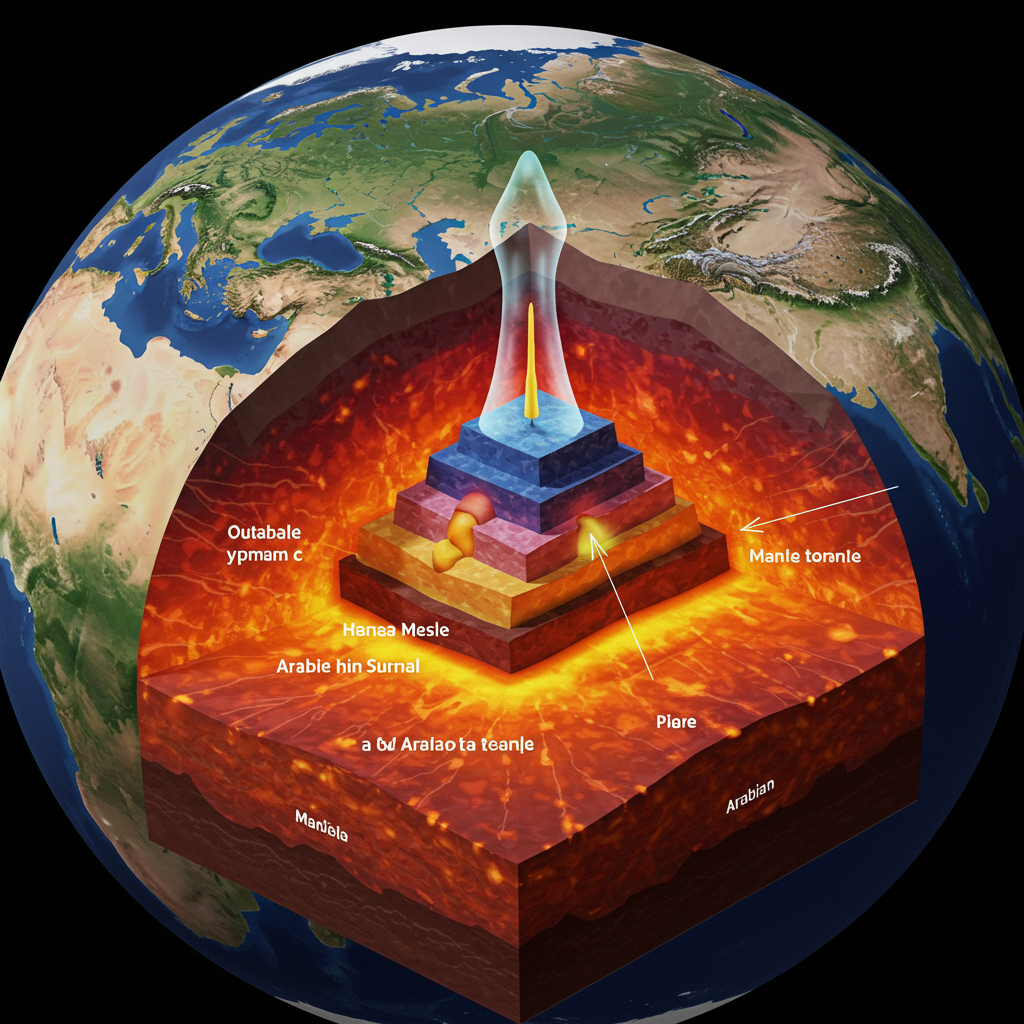Scientists have made a groundbreaking discovery deep beneath the Arabian Peninsula, identifying what they describe as the first clear example of a “ghost” mantle plume. Unlike the well-known plumes that fuel volcanic hotspots like Hawai’i and Iceland, this newly found feature, dubbed the “Dani plume,” exists without causing any current volcanic activity at the surface.
Understanding Earth’s Powerful Plumes
Mantle plumes are colossal columns of superheated rock believed to rise from the boundary between Earth’s outer core and the mantle. As these plumes ascend, they bring intense heat towards the planet’s crust. Typically, this heat triggers the melting of surrounding rock, producing magma that can erupt as volcanoes on the surface. While many confirmed plumes lie beneath the oceans, the thicker crust of continents makes it harder for this heat to break through and cause eruptions.
Geologists have long theorized about the existence of “ghost” plumes – those that make the upward journey through the mantle but remain hidden, never causing volcanic outbreaks. However, confirming something that leaves no surface trace has historically been a significant challenge.
Listening to Earth’s Deep Interior
The discovery of the Dani plume beneath Oman was made possible by analyzing the behavior of seismic waves. These waves, generated by distant earthquakes, travel through Earth’s layers, and their speed changes depending on the temperature and composition of the material they pass through. Researchers deployed a dense network of seismic stations across Oman and the United Arab Emirates, including 30 permanent and 85 temporary ones, to capture this crucial data.
The seismic analysis unveiled a large region beneath eastern Oman where waves slowed down significantly. This reduced velocity is a tell-tale sign of rock that is less rigid and therefore hotter than its surroundings. This anomalous zone was estimated to be about 200 kilometers across near its base, widening to roughly 350 km directly beneath the crust. Further analysis of seismic wave discontinuities – boundaries deep within the mantle where mineral phase changes occur (normally found at 410 km and 660 km depths) – revealed shifts consistent with a hot upwelling feature extending deep into the mantle.
A Trapped Giant Beneath the Crust
The seismic data paints a picture of a plume of material estimated to be 100°C to 300°C hotter than the surrounding mantle rock. It rises until it encounters the relatively cooler, rigid continental crust and upper mantle, where it appears to spread out like a mushroom cloud, unable to break through. This thick overlying layer prevents the superheated rock from undergoing the decompression melting necessary to form the magma that feeds volcanoes. This is why the Dani plume is considered “amagmatic,” a ghost hidden beneath the surface.
Modern Uplift and Ancient Influence
Despite its lack of volcanic fireworks, the Dani plume is not inactive. Researchers propose it is responsible for the present-day uplift of eastern Oman, including the Salma Plateau, which reaches heights of up to 2,000 meters (6,600 feet). While relatively modest, this uplift suggests the plume is still actively pushing upwards from below.
Even more remarkably, the study suggests the plume played a significant role in ancient Earth history. The authors argue that in the late Eocene epoch, roughly 40 to 34 million years ago, the shear stress generated by the Dani plume was likely the cause of a previously unexplained shift in the movement direction (azimuth) of the Indian tectonic plate. This influence ultimately impacted the timing and nature of India’s eventual collision with Asia. While plumes generally stay stationary as plates move over them, any geological record left on the Indian plate by the Dani plume would have been erased by subsequent subduction.
It’s possible that some material from the Dani plume initially reached high enough millions of years ago to cause ancient volcanic activity, but if so, any evidence of this has likely been erased by geological processes like subduction as the Arabian plate converged with Eurasia.
Are ‘Ghost’ Plumes Common?
The discovery of the Dani plume raises a fundamental question: Is it a unique geological phenomenon, or do many other “ghost” plumes lurk unseen beneath Earth’s continents? While a definitive answer requires more research, the scientists point to existing seismic anomalies in various regions, such as parts of Africa and older areas of the Pacific Ocean (like the Coral Sea), as potential candidates for further investigation. Evidence also suggests the existence of ancient ghost plumes (“ghosts of ghosts”) beneath areas like North America and Australia.
The potential commonality of ghost plumes has significant implications for our understanding of Earth’s deep interior and its thermal evolution. It challenges the previous assumption that the absence of volcanism on continents necessarily means the absence of underlying plumes. Moreover, if numerous hidden plumes are transferring heat from the core-mantle boundary towards the crust without triggering eruptions, it could mean that current estimates of the heat flowing from Earth’s core are significantly underestimated.
This groundbreaking study, published in the journal Earth and Planetary Science Letters, unveils a hidden aspect of our dynamic planet, suggesting that much more is happening beneath our feet than the surface reveals. The Dani plume is just the first clear example of a geological feature that reminds us how much we still have to learn about the complex forces shaping Earth.




